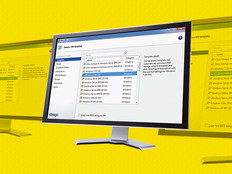Zero vs Thin vs Thick Clients: What's Right for Your Business?
How thin can you go? New clients continue to be introduced, like HP’s unveiling of the t310 G2 All-in-One Zero Client in January. With client types on the market ranging from traditional thick desktop computers to PC over IP zero clients and everything in between, IT decision-makers are left with tough questions as they try to parse out the differences and best uses of various client types.
By considering the particular strengths of thick clients vs. thin clients vs. zero clients around several key attributes, IT teams can implement the right solutions to meet the need of their businesses.
VIDEO: See what technologies are driving the evolution of the data center!
What Is a Zero Client: The Security Benefits and Beyond
One of the signature strengths of zero clients is security. Because a zero client has no local operating system, the avenues of attack are radically reduced.
But, says David Johnson, a principal analyst at Forrester, even a zero client carries some degree of vulnerability.
“Zero clients have at least some firmware,” says Johnson. “Firmware is vulnerable to attack, or can be. But in general, it should be easier to secure a zero client. With an entire PC there are a lot of attack surfaces.”
He stresses that security is more than just a matter of device; it’s also a matter of the engineering of the system as a whole. And it’s important not to discount entire classes of products under the general labels of “thick,” “thin” or “zero.”
“You can also argue that something like an iPad can be used as a thick client because it has a pretty strong operating system on it, and it’s used for productivity in its own right,” says Johnson. “But they’re also extremely secure devices — incredibly secure devices, difficult to break and hack.”
He recommends thinking through security needs and selecting not necessarily the most secure setup, but rather an appropriately secure setup that won’t unnecessarily hinder productivity, and to consider opportunities to secure the system at the physical infrastructure level.
Consider an Ecosystem Approach to Client Performance
Performance is another key attribute of thick, thin and zero clients. Brian Madden, an end-user computing strategist for VMware, notes that traditionally, rich graphics and the virtual environments thin and zero clients rely on haven’t mixed.
But, says Madden, within the last half decade, that reality has changed.
“It’s certainly possible to make a virtual desktop environment that performs just as well,” says Madden. “It’s even possible to make one that performs better, because storage in the data center is higher-performance.”
He recommends IT teams look at the entire computing environment in order to determine less obvious elements of performance, like server loading and electrical use. A thin or thick client may be able to share the computing load with the data center and drive savings in server costs and power consumption.
“You have to look at the whole ecosystem,” says Madden. “Look at what server you’re using, what applications you’re using, what technologies are in place.”
CASE STUDY: See how Atlantic Packaging future-proofed its infrastructure!
Virtualization at a Dead Heat for Thin, Thick and Zero Clients
Each type of client, whether thick, thin or zero, can work beautifully in a virtual desktop infrastructure environment, so user needs can really drive the decision-making process in this realm.
“What matters is what capabilities you’re going to be exposing to end users,” explains Johnson. The requirements of an employee who does routine videoconferencing are different that those of an employee doing advanced engineering and design, he says.
“The needs for computing power will govern, more than anything else, what the right approach is,” says Johnson. Thin clients might have a slight edge, he concedes, over zero clients — they have a degree of flexibility that zero clients do not.
Thick Clients Cater to Employees on the Move
When it comes to mobility, user needs are once again the key to determining the best approach.
“The more applications somebody uses and the more locations from which they work, the more the argument is for a thick client,” says Johnson. “They need that flexibility, they need that strength, they need that level of control.”
He contrasts that with someone who works from a single location and uses only one or two applications. In that situation, a thin client or zero client can be an elegant solution that puts as few barriers as possible between the user and the application.
Keep in mind, too, the differences between remote workers — who may be able to easily access a VDI from a strong, stable internet connection in their home or selected remote workplace — and truly mobile workers who may be using unreliable airplane or coffee shop Wi-Fi or a cellular connection, and for whom accessing a VDI from any type of client may prove difficult.
“You’re going to cripple people for large chunks of time when they’re not going to be connected in a way that’s suitable for VDI,” cautions Johnson.
Thin Clients and Zero Clients in the Cloud
If you’re moving to thin or zero clients to take advantage of cloud-based Desktop as a Service, there are definite advantages, says Madden. Rather than setting up and maintaining on-premises servers, businesses can simply pay a per-month fee; because there’s nothing to configure with a thin or zero client, accessing the system is simply a matter of logging in.
He points to VMware Horizon, VMware’s desktop virtualization product, as an example. “You can buy it and install it on-premises, you can build your own servers, install the software, run your own desktop virtualization environment, but you can also use Horizon as a service running on Azure,” he says.
“The advantages of desktop virtualization are the same, but by having it on Azure, the customer doesn’t have to buy the hardware upfront,” he adds — a way of combining the traditional benefits of the cloud with the strengths of thin and zero clients.
Choosing Between Thick, Thin and Zero Clients
Ultimately, choosing between thick, thin and zero clients must be approached from a knowledge of the computing requirements of the employees.
“Before anything else, it has to start with what the end users’ needs truly are,” says Johnson. “For mobility, for productivity, for flexibility — it has to stem from there.”
He worries that businesses that overstate their security needs, for example, end up stifling the productivity of their employees with an inadequate or overly locked-down solution. Working backward from end user needs to a product helps avoid that fate.
It’s also rare that one type of client will be optimal for every employee in an organization, and it’s not necessary that a single type of client be deployed. Johnson highly recommends considering which roles need traditional desktop computers with applications running locally and which would be better served with thin or zero clients operating with virtual desktops, and to provision them accordingly.
There’s no single right answer for every business. But with a solid handle on requirements at a granular level, the right answer can be found for every business.









